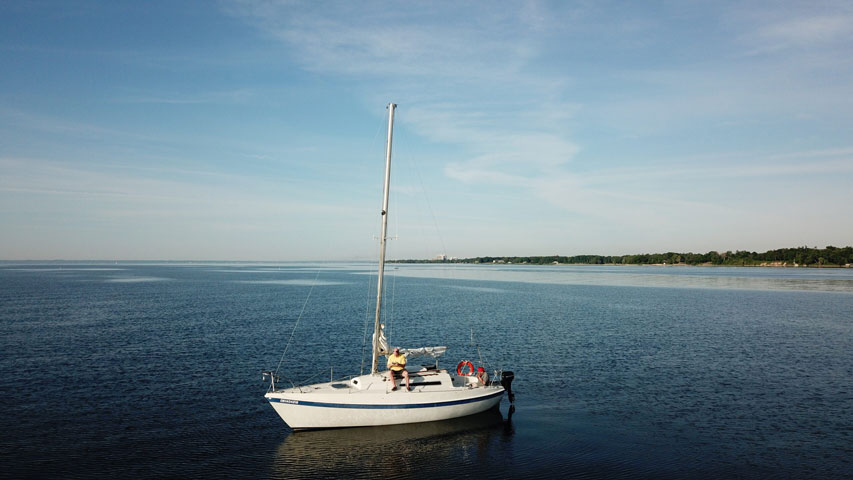Preparing Your Sailboat for Winter
Ah… the unfortunate time of the year where some of us have to pack up our sails, move our boat into storage and not be where we really want to be… out on the water. Checkout the handy infographic below for some tips and tricks on how to ensure your boat survives through the winter so you can enjoy another season on the water when the weather changes. Not winterizing your boat can lead to serious consequences. If you’re one of the lucky ones who doesn’t have to worry about the cold, the rest of us are jealous of you.

Sails
The first thing to tackle is taking your sails off the boat entirely and storing them in a dry, safe place away from vermin, moisture and the weather.
A general list you can use during sail inspect to understand which sail maintenance you may need to undertake is as follows:
- Inspect attachment points of the sail.
- Look at the edges of the sail.
- Check for chafe, tears and other damage.
- Examine accessories.
- Evaluate the cloth.
A more detailed blog on checking your sails at home can be viewed with the following link.
At this point, it is a good opportunity to clean your sails. For more information on cleaning you sails check out our cleaning sails blog post.
After you inspect and clean your sails and ensure they are dry it’s time to fold them up and put them somewhere safe like in a garage or storage locker off the ground – this blog and video demonstrates how easy it can be to fold sails.
Cleaning
After you pack your sails away the next step is to take care of the hull and the internals of the boat. Now, is a perfect time to take the opportunity to clean your boat. Inside and out. Swabbing the deck and organizing all your belongings will put you ahead of the curve for your winterization process. If your boat is out of the water cleaning it becomes much easier. Pressure wash the entire exterior of the boat, including the bottom side and prop. This way you can inspect for damage and paint the bottom of your boat if you wish. A nice wax and polish will make your baby shine like she was brand new. All you need is a couple rags, an orbital polisher, marine polishing compound, wax, some elbow grease, and a couple days.
Eliminating Water
The most important thing to keep in mind when winterizing your boat is water. In this case, water is your enemy. You need to do whatever you can to get it out of all your systems.
These systems include:
- The head.
- Water heater.
- Engine cooling system.
- Bilge.
- Fresh water reserves.
Get any and all water you can out! You can’t leave your systems dry however, what you want to put in place of the water is marine grade non-toxic propylene glycol based antifreeze. Having the antifreeze in your systems ensures that they will not freeze and burst or deteriorate as quickly.
This antifreeze is safe to put in every water containing system you have on your boat. The chemical base in these products is used in the food industry and is considered safe by US and EU food authorities. They are also biodegradable and not harmful to wildlife.
Propylene glycol antifreeze is corrosion preventing and has lubricating properties which maintain the plastics and seals throughout your systems. If you have ever been to or raced on a racetrack you know that coolant spills are very serious and dangerous because the liquid is so slippery.
Engine
The next thing to do is change your oil and filter. Swapping out the oil ensures dirty oil used throughout the summer months doesn’t sit and corrode your engine from built up contaminants.
The engine is sensitive to cracking if you don’t drain the water and replace it with antifreeze. Drain your seacocks and fill the intakes with antifreeze.

Fuel System
We can’t forget about the fuel tank and systems. The goal here is to reduce corrosion opportunities to occur. Make sure to full your tank to reduce the amount of air in your tank. If there is space for air to be in the tank that means there’s room for condensation as well. Water in your fuel tank is harmful to the fuel itself and the tank. Add fuel stabilizer to remove the harmful properties of ethanol in gas which will erode plastic hoses.
For diesel engines – if you leave diesel tanks half full algae will grow. The easiest fix for this is to fill the tank and add other diesel fuel additives and biocide.
Batteries
Make sure your batteries are fully charged and have them disconnected from sources drawing from their power. If you’re worried about them you can just bring them home and hook them up to a battery tender.

Boat Cover
Finally it’s time to cover your boat. We just prevented everything from being wet now its time to keep it dry. Get a boat cover. It doesn’t have to be expensive, make one out of tarps and bungee cord if you have to. Your priority is to shield the boat from the weather, anything helps.
Not satisfied? Browse the spring checklist for more information on how to get your boat ready for spring.


